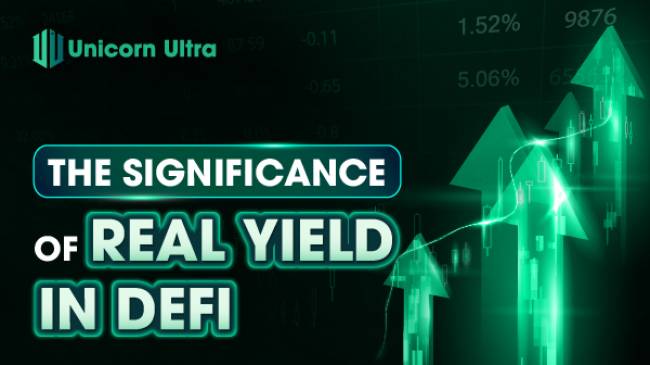Decentralized Finance (DeFi) has revolutionized the traditional financial landscape, introducing the concept of real yield. In this blog, we delve into the origins and importance of real yield in DeFi protocols. We also examine the current trends in real yield and highlight notable platforms that offer attractive returns. Join us as we explore what is Real Yield, the power of real yield and uncover opportunities for maximizing your investments in the decentralized world of finance.
Table of Contents
What is Real Yield in DeFi?
What is Real Yield? Real yield in DeFi refers to the actual return on investment in decentralized finance protocols, accounting for inflation and other relevant factors. It provides investors with an accurate measure of their earnings in terms of purchasing power.

The Origins of Yield in DeFi Protocols
Yield in DeFi protocols originated as an incentive mechanism to attract participants and liquidity providers. These protocols employ smart contracts to automate financial transactions, enabling users to lend, borrow, trade, and stake their digital assets. Users receive rewards, such as tokens or interest-bearing assets, for their involvement.
Initially, yield was derived from transaction fees and inflationary mechanisms within the protocol. However, as the DeFi landscape evolved, yield generation expanded to include governance rewards, liquidity mining, and token staking.

The Importance of Real Yield
Understanding the significance of real yield is crucial for DeFi investors. Unlike traditional finance, where yields may be eroded by inflation, taxes, and other factors, DeFi protocols offer the potential for higher returns that outpace inflation. Real yield allows investors to accurately assess the profitability of their investments and make informed decisions.
Focusing on real yield safeguards purchasing power and ensures that returns are not diminished over time. This approach empowers individuals to preserve and grow their wealth within the rapidly expanding DeFi ecosystem.
What are the benefits of Real Yield in DeFi?
Real Yield calculations in DeFi offer several important benefits to users and investors in the decentralized finance ecosystem. These benefits help users make informed decisions about where to allocate their assets and assess the true returns they can expect. Here are the key advantages of considering Real Yield in DeFi:
-
Accurate Return Assessment: Real Yield provides a more accurate picture of the actual return on investment (ROI) or interest earned on assets in the DeFi ecosystem. It accounts for factors like inflation and transaction fees, ensuring that users have a realistic expectation of their earnings.
-
Value Preservation: By deducting inflation from the nominal yield, Real Yield helps users assess the extent to which their assets are preserving their purchasing power over time. It encourages users to seek investments that not only offer high nominal yields but also outpace inflation.
-
Risk Mitigation: Real Yield calculations can assist users in evaluating the risk-reward trade-off of various DeFi investments. It allows users to identify assets or platforms that offer attractive Real Yields while minimizing exposure to inflation and fees.
-
Informed Decision-Making: Real Yield empowers DeFi users to make more informed decisions about where to allocate their assets. It helps users compare different investment options and choose those that align with their financial goals and risk tolerance.
-
Asset Diversification: DeFi users can use Real Yield as a criterion for diversifying their crypto portfolios. By allocating assets to assets or platforms with favorable Real Yields, they can enhance portfolio stability and potential returns.
-
Hedging Against Inflation: Inflation can erode the value of fiat currencies and crypto assets alike. Real Yield calculations enable users to identify assets or strategies that can serve as hedges against inflation, potentially preserving wealth over the long term.
-
Long-Term Planning: Real Yield considerations are particularly valuable for long-term investors and savers who aim to grow their wealth or generate income over an extended period. It helps them make sustainable financial plans.
-
Optimization of DeFi Strategies: DeFi participants, including liquidity providers and yield farmers, can use Real Yield calculations to optimize their strategies. This can involve choosing liquidity pools or protocols that offer higher Real Yields and lower fees.
-
Transparency and Accountability: By focusing on Real Yield, DeFi platforms and projects can demonstrate transparency and accountability to their users. This can foster trust and attract more participants to the ecosystem.
It's important to note that Real Yield calculations can vary based on the specific DeFi platform, assets involved, market conditions, and the accuracy of inflation data. Users should conduct thorough research and due diligence when assessing Real Yields and consider the associated risks and uncertainties in the DeFi space. Additionally, staying updated on the latest developments and using reliable data sources is crucial for accurate Real Yield assessments.
Current Trends in Real Yield
The trend of real yield in DeFi has gained substantial traction in recent years. Innovative yield farming strategies have allowed liquidity providers and investors to capitalize on attractive returns. DeFi protocols continually develop mechanisms to incentivize participation and attract capital, fueling the growth of real yield opportunities.
Additionally, yield optimization platforms and decentralized aggregators have simplified the process of maximizing real yield. These tools automatically analyze various DeFi protocols and allocate funds to generate the highest possible returns. Such advancements democratize access to real yield, making it available to a wider range of investors.

Prominent DeFi Protocols Offering Real Yield
Several DeFi protocols have gained prominence by offering significant real yields. Notable examples include:
Compound: A platform for lending and borrowing, Compound enables users to earn interest on deposited assets or borrow against them.
Aave: A decentralized lending platform that allows users to lend their assets and earn interest while retaining control over their funds.
Synthetix: Synthetix provides a platform for trading and minting synthetic assets, offering rewards for providing liquidity to synthetic asset pools.
Yearn.finance: An aggregator platform that automatically reallocates funds to different DeFi protocols to maximize yield.
These protocols represent a fraction of the diverse array of DeFi platforms offering real yield opportunities. Thorough research, risk evaluation, and consideration of investment goals are essential before participating in any DeFi venture.
How to find DeFi projects with Real Yield?
Finding DeFi projects with Real Yield requires a combination of research, analysis, and the use of various tools and resources. Here are steps you can follow to identify and evaluate DeFi projects that offer competitive Real Yields:
-
Stay Informed: Keep up-to-date with the latest news and developments in the DeFi space by following reputable crypto news websites, forums, and social media channels. Understand the current state of the DeFi market, including trends and popular projects.
-
Use DeFi Analytics Platforms: DeFi analytics platforms can provide valuable insights into the performance of DeFi projects. Websites like DeFi Pulse, DeBank, and DeFiLlama offer data on total value locked (TVL), yield farming opportunities, and more.
-
Explore DeFi DApps: Visit decentralized applications (DApps) or platforms that offer yield farming, lending, staking, and liquidity provision services. Popular DeFi platforms include Compound, Aave, Uniswap, SushiSwap, Curve Finance, and many others.
-
Check Token Metrics: Analyze the tokens associated with DeFi projects. Look for information about tokenomics, including inflation rates, token distribution, and any mechanisms that impact token value and yield.
-
Review Whitepapers: If available, read the project's whitepaper or documentation to understand its goals, technology, governance, and economic model. Pay attention to any information related to token rewards and staking.
-
Examine Historical Data: Review historical data on the project's performance, including its token's price, trading volume, TVL, and yield rates. Analyze whether the project has maintained stable or increasing Real Yields over time.
-
Calculate Real Yield: Calculate the Real Yield for specific DeFi platforms by deducting inflation rates and transaction fees from the nominal yield. Make sure to use accurate and up-to-date data for these calculations.
-
Assess Risk: Evaluate the risks associated with each DeFi project. Consider factors such as smart contract security, governance structure, and the project's track record. High Real Yields may come with increased risk, so balance potential returns with risk tolerance.
-
Seek Community Feedback: Join DeFi-related forums, social media groups, and communities to gather insights and feedback from other DeFi enthusiasts. Learn from their experiences and ask questions about specific projects.
-
Diversify: Instead of concentrating all your assets in a single DeFi project, consider diversifying your holdings across multiple projects to spread risk. Diversification can help mitigate the impact of potential losses.
-
Stay Cautious: Exercise caution when investing in DeFi projects, especially those that promise exceptionally high yields. Beware of potential scams and conduct thorough due diligence before providing liquidity or locking assets.
-
Use Wallets and Tools: Utilize cryptocurrency wallets and DeFi management tools that integrate with multiple DeFi platforms. These tools can simplify asset management and help you track your Real Yields.
Remember that the DeFi space is highly dynamic, and new projects continuously emerge. Always stay informed, be prepared for market volatility, and consider consulting with financial professionals or experts if you have questions or concerns about your DeFi investments.
Conclusion
In conclusion, real yield in DeFi represents the true measure of return on investment, accounting for inflation and other factors. Understanding what is Real Yield, its origins, importance, current trends, and leading platforms offering real yields enables investors to navigate the DeFi landscape confidently. Embracing the power of real yield unlocks opportunities for higher returns and long-term wealth preservation within the decentralized finance ecosystem. Let's go with U2U to follow the latest information on the market.






